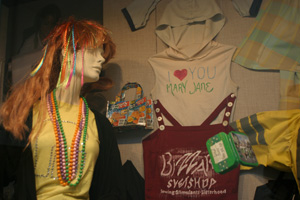A vintage T-shirt, the dress from a girls’ private school uniform and an old fireman’s jacket make up just one of more than 50 ensembles in an exhibition at Cornell University.

Denise Green is a Cornell senior who worked on collecting authentic examples of street style for the exhibit “Street Fashion and Youth Subculture: An Ethnographic Costume Exhibition.” After years of research, she said street fashion is deeper than it may seem.
“It conveys everything about one’s self, from their lifestyle to their political beliefs,” she said. “All of this is in the garments that they wear.”
The exhibit, on display in The Elizabeth Schmeck Brown Costume and Textile Gallery in Cornell’s Martha Van Rensselaer Hall, is the culmination of a three-year ethnographic-research project led by Van Dyke Lewis, assistant professor of fiber science and apparel design. Lewis, along with Green and seven other students, did extensive research on street fashion in Ithaca and how different youth subcultures define themselves by their clothing.
The student researchers immersed themselves in the culture of five different groups found in Ithaca, which Lewis labels as American princesses, hipsters, hip-hop, cross-dressing women and neo-hippies. The students interviewed, photographed and even dressed like members of these subcultures to get a feel for how the groups used clothing as a way to identify themselves.
“Street fashion enables people to … have a voice,” Lewis said. “With street style comes belonging, being able to articulate yourself within a group.”
The exhibition began to take form when Charlotte Jirousek, associate professor of fiber science and apparel design and the exhibit’s curator, approached Green about presenting the project visually.
“I thought that what we really ought to be doing was collecting, taking people shopping and getting real examples,” Jirousek said. “That would be the most concrete way of documenting the project.”
Green and Jirousek then set out to collect examples of the street fashion she had been researching to add to Cornell’s already extensive Costume and Textile Collection.
“We thought that if we could collect authentic examples of [street fashion] then we would have that preserved in our collection,” Green said. “Two hundred years from now, people could look back on these trends and see the different places that trickle up.”
By “trickle up,” Green is referring to the process of trends emerging from street fashion and youth subculture groups and later being adopted by high-end fashion designers.
The collection expands upon the original five groups to include
grunge, featuring a Nirvana T-shirt from 1995 and ripped Levi’s jeans, and Asian American, which contrasts a high-end Comme des Garcons skirt with tattered, multicolored Adidas sneakers, among others.
The outfits combine clothes donated or lent out by people who Green and others surveyed as part of the research project, and outfits that were put together by members of different subcultures using articles from the Costume and Textile Collection.
Student researchers took subjects to the local Salvation Army and asked them to create an outfit from items in the store that they thought represented themselves. One look was referred to as “The Cross-Dressing Woman Ensemble” and is made up of layered skirts, a hooded sweatshirt and briefcase.
Jirousek said the items featured in the exhibit are an innovative addition to the collection because they are whole ensembles that directly represent certain groups within our culture, as opposed to individual items that were donated to the collection. Jirousek said the outfits are head-to-foot ensembles.
“They have all the stories that go with them,” Jirousek said. “They say something about a person’s identity, values and culture in this particular time and place.”



